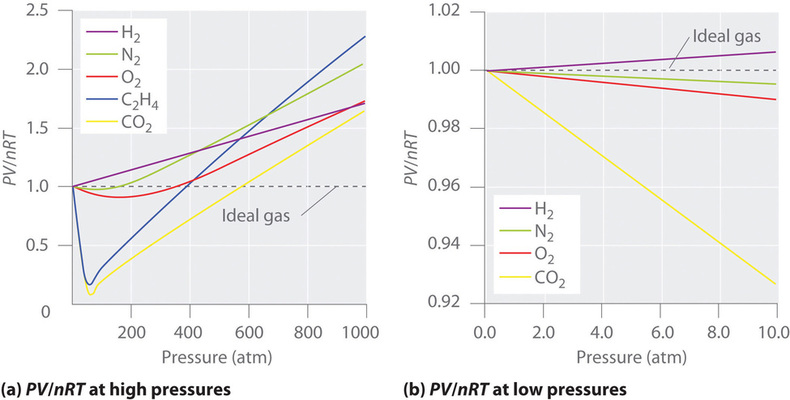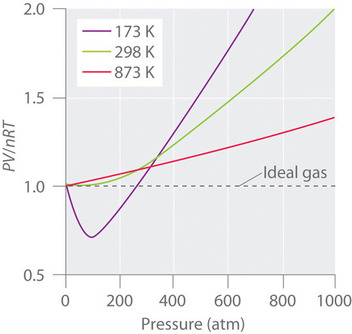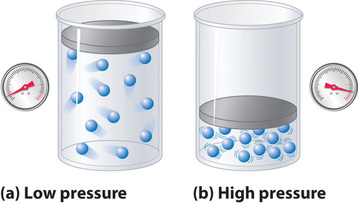Why Do Gases Experience More Ideal Behavior As Temperature Increases And Pressure Decreases?
10.9: Existent Gases - Deviations from Ideal Behavior
- Page ID
- 21767
Learning Objectives
- To recognize the differences betwixt the behavior of an platonic gas and a real gas
- To understand how molecular volumes and intermolecular attractions cause the properties of real gases to deviate from those predicted by the ideal gas law.
The postulates of the kinetic molecular theory of gases ignore both the volume occupied past the molecules of a gas and all interactions between molecules, whether bonny or repulsive. In reality, however, all gases have nonzero molecular volumes. Furthermore, the molecules of existent gases interact with 1 another in ways that depend on the structure of the molecules and therefore differ for each gaseous substance. In this section, we consider the backdrop of real gases and how and why they differ from the predictions of the platonic gas law. We also examine liquefaction, a cardinal belongings of real gases that is not predicted by the kinetic molecular theory of gases.
Force per unit area, Volume, and Temperature Relationships in Real Gases
For an ideal gas, a plot of \(PV/nRT\) versus \(P\) gives a horizontal line with an intercept of ane on the \(PV/nRT\) axis. Real gases, however, show meaning deviations from the behavior expected for an platonic gas, specially at loftier pressures (Effigy \(\PageIndex{1a}\)). Merely at relatively depression pressures (less than one atm) practice real gases approximate platonic gas behavior (Figure \(\PageIndex{1b}\)).

Real gases also approach ideal gas behavior more closely at higher temperatures, as shown in Effigy \(\PageIndex{2}\) for \(N_2\). Why do real gases behave so differently from platonic gases at high pressures and depression temperatures? Under these atmospheric condition, the two basic assumptions backside the ideal gas police force—namely, that gas molecules accept negligible volume and that intermolecular interactions are negligible—are no longer valid.

Because the molecules of an platonic gas are assumed to have zero book, the volume available to them for motion is always the same as the volume of the container. In contrast, the molecules of a existent gas take pocket-sized but measurable volumes. At depression pressures, the gaseous molecules are relatively far apart, but as the pressure level of the gas increases, the intermolecular distances become smaller and smaller (Effigy \(\PageIndex{three}\)). As a result, the volume occupied past the molecules becomes significant compared with the volume of the container. Consequently, the total volume occupied past the gas is greater than the volume predicted by the ideal gas law. Thus at very high pressures, the experimentally measured value of PV/nRT is greater than the value predicted by the platonic gas law.

Moreover, all molecules are attracted to one another by a combination of forces. These forces become particularly important for gases at low temperatures and high pressures, where intermolecular distances are shorter. Attractions betwixt molecules reduce the number of collisions with the container wall, an issue that becomes more than pronounced as the number of attractive interactions increases. Because the boilerplate distance betwixt molecules decreases, the pressure level exerted past the gas on the container wall decreases, and the observed pressure is less than expected (Figure \(\PageIndex{iv}\)). Thus every bit shown in Figure \(\PageIndex{2}\), at low temperatures, the ratio of \(PV/nRT\) is lower than predicted for an platonic gas, an effect that becomes specially axiomatic for complex gases and for simple gases at depression temperatures. At very loftier pressures, the effect of nonzero molecular volume predominates. The competition between these effects is responsible for the minimum observed in the \(PV/nRT\) versus \(P\) plot for many gases.
Nonzero molecular volume makes the actual volume greater than predicted at loftier pressures; intermolecular attractions make the force per unit area less than predicted.
At loftier temperatures, the molecules have sufficient kinetic energy to overcome intermolecular bonny forces, and the effects of nonzero molecular volume predominate. Conversely, as the temperature is lowered, the kinetic energy of the gas molecules decreases. Eventually, a point is reached where the molecules can no longer overcome the intermolecular attractive forces, and the gas liquefies (condenses to a liquid).
The van der Waals Equation
The Dutch physicist Johannes van der Waals (1837–1923; Nobel Prize in Physics, 1910) modified the ideal gas law to draw the behavior of real gases by explicitly including the effects of molecular size and intermolecular forces. In his description of gas beliefs, the then-called van der Waals equation,
\[ \underbrace{ \left(P + \dfrac{an^2}{V^2}\right)}_{\text{Force per unit area Term}} \overbrace{(5 − nb)}^{\text{Pressure Term}} =nRT \label{ten.ix.1}\]
a and b are empirical constants that are different for each gas. The values of \(a\) and \(b\) are listed in Table \(\PageIndex{ane}\) for several common gases.
| Gas | a ((L2·atm)/mol2) | b (L/mol) |
|---|---|---|
| He | 0.03410 | 0.0238 |
| Ne | 0.205 | 0.0167 |
| Ar | 1.337 | 0.032 |
| H2 | 0.2420 | 0.0265 |
| Northwardtwo | ane.352 | 0.0387 |
| O2 | ane.364 | 0.0319 |
| Cl2 | six.260 | 0.0542 |
| NH3 | 4.170 | 0.0371 |
| CHiv | ii.273 | 0.0430 |
| COtwo | three.610 | 0.0429 |
The pressure term in Equation \(\ref{10.9.ane}\) corrects for intermolecular attractive forces that tend to reduce the pressure from that predicted by the ideal gas police. Here, \(n^2/V^ii\) represents the concentration of the gas (\(n/Five\)) squared because it takes two particles to engage in the pairwise intermolecular interactions of the type shown in Effigy \(\PageIndex{four}\). The volume term corrects for the book occupied by the gaseous molecules.

The correction for book is negative, but the correction for pressure is positive to reflect the effect of each factor on 5 and P, respectively. Because nonzero molecular volumes produce a measured volume that is larger than that predicted by the platonic gas law, we must decrease the molecular volumes to obtain the actual volume available. Conversely, attractive intermolecular forces produce a pressure that is less than that expected based on the ideal gas police force, so the \(an^2/V^2\) term must be added to the measured pressure to correct for these effects.
Example \(\PageIndex{1}\)
Y'all are in charge of the manufacture of cylinders of compressed gas at a small visitor. Your company president would like to offer a 4.00 L cylinder containing 500 thousand of chlorine in the new catalog. The cylinders you have on hand take a rupture pressure of xl atm. Utilise both the ideal gas police force and the van der Waals equation to calculate the pressure in a cylinder at 25°C. Is this cylinder probable to be safety against sudden rupture (which would be disastrous and certainly issue in lawsuits because chlorine gas is highly toxic)?
Given: book of cylinder, mass of compound, pressure, and temperature
Asked for: safety
Strategy:
A Use the tooth mass of chlorine to calculate the amount of chlorine in the cylinder. And so calculate the pressure of the gas using the ideal gas police.
B Obtain a and b values for Cl2 from Table \(\PageIndex{1}\). Utilize the van der Waals equation (\(\ref{10.ix.ane}\)) to solve for the pressure of the gas. Based on the value obtained, predict whether the cylinder is likely to be safe against sudden rupture.
Solution:
A Nosotros begin by calculating the amount of chlorine in the cylinder using the molar mass of chlorine (seventy.906 chiliad/mol):
\[\begin{align} due north &=\dfrac{m}{M} \\[4pt] &= \rm\dfrac{500\;thou}{70.906\;m/mol} \\[4pt] &=7.052\;mol\nonumber \end{marshal} \]
Using the ideal gas police force and the temperature in kelvin (298 K), we calculate the pressure:
\[\begin{align} P &=\dfrac{nRT}{V} \\[4pt] &=\rm\dfrac{7.052\;mol\times 0.08206\dfrac{L\cdot atm}{mol\cdot K}\times298\;K}{4.00\;50} \\[4pt] &= 43.1\;atm \end{align} \]
If chlorine behaves like an ideal gas, you have a real problem!
B Now permit's apply the van der Waals equation with the a and b values for Clii from Table \(\PageIndex{one}\). Solving for \(P\) gives
\[\brainstorm{align}P&=\dfrac{nRT}{V-nb}-\dfrac{an^2}{V^2}\\&=\rm\dfrac{7.052\;mol\times0.08206\dfrac{L\cdot atm}{mol\cdot G}\times298\;K}{4.00\;L-7.052\;mol\times0.0542\dfrac{Fifty}{mol}}-\dfrac{six.260\dfrac{Fifty^2atm}{mol^2}\times(7.052\;mol)^ii}{(4.00\;L)^two}\\&=\rm28.2\;atm\end{align}\]
This force per unit area is well inside the safety limits of the cylinder. The ideal gas constabulary predicts a pressure 15 atm higher than that of the van der Waals equation.
Exercise \(\PageIndex{1}\)
A x.0 Fifty cylinder contains 500 g of methane. Calculate its pressure to two significant figures at 27°C using the
- ideal gas constabulary.
- van der Waals equation.
- Answer a
-
77 atm
- Answer b
-
67 atm
Liquefaction of Gases
Liquefaction of gases is the condensation of gases into a liquid course, which is neither anticipated nor explained by the kinetic molecular theory of gases. Both the theory and the ideal gas police predict that gases compressed to very loftier pressures and cooled to very depression temperatures should still bear like gases, albeit common cold, dense ones. As gases are compressed and cooled, however, they invariably condense to form liquids, although very low temperatures are needed to liquefy light elements such as helium (for He, four.2 K at 1 atm force per unit area).
Liquefaction can be viewed as an extreme deviation from ideal gas behavior. It occurs when the molecules of a gas are cooled to the point where they no longer possess sufficient kinetic free energy to overcome intermolecular attractive forces. The precise combination of temperature and force per unit area needed to liquefy a gas depends strongly on its molar mass and construction, with heavier and more complex molecules usually liquefying at college temperatures. In general, substances with large van der Waals \(a\) coefficients are relatively like shooting fish in a barrel to liquefy because large a coefficients indicate relatively stiff intermolecular attractive interactions. Conversely, minor molecules with only calorie-free elements accept small a coefficients, indicating weak intermolecular interactions, and they are relatively difficult to liquefy. Gas liquefaction is used on a massive scale to split up O2, N2, Ar, Ne, Kr, and Xe. After a sample of air is liquefied, the mixture is warmed, and the gases are separated co-ordinate to their humid points.
A big value of a in the van der Waals equation indicates the presence of relatively strong intermolecular attractive interactions.
The ultracold liquids formed from the liquefaction of gases are called cryogenic liquids, from the Greek kryo, meaning "cold," and genes, meaning "producing." They accept applications equally refrigerants in both manufacture and biological science. For example, nether carefully controlled conditions, the very cold temperatures afforded by liquefied gases such equally nitrogen (boiling point = 77 K at ane atm) can preserve biological materials, such equally semen for the bogus insemination of cows and other farm animals. These liquids can too be used in a specialized type of surgery called cryosurgery, which selectively destroys tissues with a minimal loss of claret past the utilize of farthermost cold.

Moreover, the liquefaction of gases is tremendously important in the storage and shipment of fossil fuels (Figure \(\PageIndex{5}\)). Liquefied natural gas (LNG) and liquefied petroleum gas (LPG) are liquefied forms of hydrocarbons produced from natural gas or petroleum reserves. LNG consists more often than not of methane, with small amounts of heavier hydrocarbons; it is prepared past cooling natural gas to below most −162°C. It tin be stored in double-walled, vacuum-insulated containers at or slightly above atmospheric pressure. Because LNG occupies just most 1/600 the volume of natural gas, it is easier and more than economical to transport. LPG is typically a mixture of propane, propene, butane, and butenes and is primarily used every bit a fuel for home heating. It is as well used as a feedstock for chemical plants and as an inexpensive and relatively nonpolluting fuel for some automobiles.
Summary
No real gas exhibits ideal gas behavior, although many real gases guess information technology over a range of atmospheric condition. Deviations from ideal gas behavior can be seen in plots of PV/nRT versus P at a given temperature; for an ideal gas, PV/nRT versus P = 1 under all weather condition. At high pressures, most real gases exhibit larger PV/nRT values than predicted by the ideal gas police force, whereas at low pressures, most real gases showroom PV/nRT values close to those predicted by the ideal gas law. Gases most closely approximate ideal gas behavior at high temperatures and low pressures. Deviations from ideal gas police behavior tin be described by the van der Waals equation, which includes empirical constants to correct for the bodily book of the gaseous molecules and quantify the reduction in pressure due to intermolecular attractive forces. If the temperature of a gas is decreased sufficiently, liquefaction occurs, in which the gas condenses into a liquid class. Liquefied gases have many commercial applications, including the transport of large amounts of gases in pocket-sized volumes and the uses of ultracold cryogenic liquids.
Why Do Gases Experience More Ideal Behavior As Temperature Increases And Pressure Decreases?,
Source: https://chem.libretexts.org/Bookshelves/General_Chemistry/Map:_Chemistry_-_The_Central_Science_%28Brown_et_al.%29/10:_Gases/10.09:_Real_Gases_-_Deviations_from_Ideal_Behavior
Posted by: davismoomple.blogspot.com


0 Response to "Why Do Gases Experience More Ideal Behavior As Temperature Increases And Pressure Decreases?"
Post a Comment